Platform 4 at London’s Elephant & Castle station was treated to a new fibreglass Dura Platform passenger walkway deck system this year, drastically improving the passenger experience and improving safety by reducing stepping distances from platform to train
The biggest challenge for any platform replacement or refurbishment is to carry out works without causing major passenger disruption and sticking to the agreed schedule. Delivering the project installation was the company’s long-time installation partner, Hammond (ECS), and who were the principal contractor to Network Rail.
Resolving excessive stepping distances
Hammond and Dura worked together to develop the mountbridge system that allowed a stepping distance adjustment of up to 200mm to deal with the varying heights along the platform. Although traditional platform material solutions could have been employed, they were ruled out on the basis that significant platform closures and line possessions would be required; a process that would have led to many months of passenger disruptions. The composite Dura Platform system was far less disruptive and quicker to install; the innovative solution not only removes the cost and disruption of the concrete option but also stands the test of time because it’s adjustable to suit future rolling stock and has a design life in excess of 50 years.
Following huge support from Network Rail, the innovative system was approved followed the successful installation of a similar composite fibreglass platform system solution at Tulse Hill, south London, in 2013. Learning from this pioneering installation, a number of technical innovations were made for the Elephant & Castle system to drive further efficiencies throughout the supply chain, most notably during installation.
Dura Composite’s specific aim was to reduce the stepping distance from the platform to the train and make it consistent to ensure that platform 4 conformed to Network Rail’s standards for height and distance X-Y dimensions. The project was a success, accomplishing full compliancy. The photographs clearly illustrate the improvements, with elderly passengers and those with luggage finding it much easier it was to board or alight the train once the new platform was installed.
Anchors and plates substructure

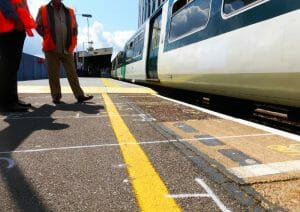
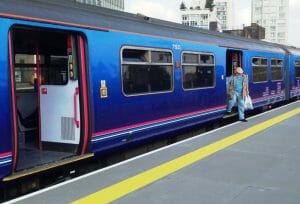 The construction of the existing platform was pre-cast concrete with deep tarmac overlay, meaning it was not realistic for Dura to utilise the concrete ground beam solution as at Tulse Hill. Extensive research and detailed technical collaborations led to the adoption of a new chemical fixing that was suitable for anchoring the substructure into the existing deep tarmac. The anchor fixing was tested independently, and also by the manufacturer, to ensure its effectiveness in its intended application.
The construction of the existing platform was pre-cast concrete with deep tarmac overlay, meaning it was not realistic for Dura to utilise the concrete ground beam solution as at Tulse Hill. Extensive research and detailed technical collaborations led to the adoption of a new chemical fixing that was suitable for anchoring the substructure into the existing deep tarmac. The anchor fixing was tested independently, and also by the manufacturer, to ensure its effectiveness in its intended application.
Another major learning developed from Tulse Hill was that rather than strip the foundations, a galvanised steel pedestal mounting plate was fixed directly to the tarmac surface with the tarmac anchors. The plate could then be pre-assembled with the requisite amount of adjustable pedestals. These plates were arranged at suitable centres, forming the primary support for the fibreglass substructure. This improved system allowed preparation work to begin during engineering hours, which resulted in less passenger disruption and more efficient use of possession times.
Installing the overlay platform
Due to the nature of lightweight modular composite flooring panels versus traditional concrete and tarmac and their associated equipment, the majority of the installation of the overlay system was conducted within engineering hours under line block arrangements. Passenger safe access was provided with a minimum of a 2,500mm wide clearance from the platform edge at all times. Pedestal mounting plate assemblies were fixed to the existing platform with the pre-installed tarmac anchors. The initial setting out of the coper line was undertaken using a suitable calibrated platform gauging tool, set off the running rail to accurately set the X and Y axis.
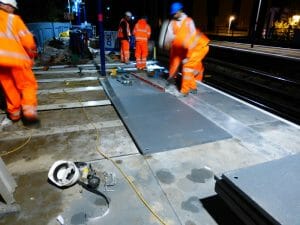
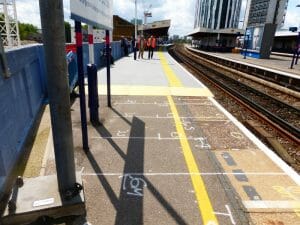 Working from the front to back of the platforms, the team would correctly level the pedestals to the coper, subsequently setting pedestals to allow a 1 in 40 back fall. Once the adjustable pedestals were installed the team fixed the fibreglass substructure c-channels into position and the levels/falls were adjusted. Additional time was taken on panels that required a tapered cut to coincide with the curvature of the existing platform.
Working from the front to back of the platforms, the team would correctly level the pedestals to the coper, subsequently setting pedestals to allow a 1 in 40 back fall. Once the adjustable pedestals were installed the team fixed the fibreglass substructure c-channels into position and the levels/falls were adjusted. Additional time was taken on panels that required a tapered cut to coincide with the curvature of the existing platform.
Expansion Bolts were used to fix the fibreglass panels to the fibreglass substructure using 30mm holes. Each fixing point was capped with a circular disc of matching fibreglass material to the anti-slip deck, to neatly conceal the fixings. This was a safety critical issue to passengers to remove any possible tripping hazards but which also complemented the decorative finish.
The Elephant & Castle installation also required door thresholds be accommodated to account for the platform height adjustment of 50-100mm, which was achieved by laying panels and substructures to suitable cross falls in two directions.
Huge benefits across supply chain
With two applications now in situ, the use of composite technology to adjust stepping distances on platforms has been proven to significantly reduce disruption to passenger services, due to the works being quicker and more accommodating to customers. Most significantly, station platforms do not need to be closed under normal circumstances as simple ramps can be used to easily smooth out the transition between old and new platforms during construction phase.
Ongoing development
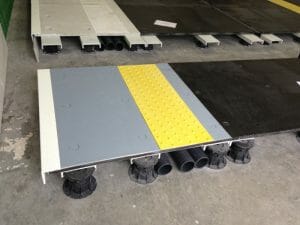 The particular solution developed for Elephant & Castle comprised height-adjustable pods secured along the platform on which fibreglass beams are positioned, providing support for the Dura Platform fibreglass station platform deck system.
The particular solution developed for Elephant & Castle comprised height-adjustable pods secured along the platform on which fibreglass beams are positioned, providing support for the Dura Platform fibreglass station platform deck system.
The walking surface features an anti-slip finish reducing the likelihood of slips, trips and falls. Also incorporated into the platform is a flush mounted bright yellow tactile that serves to replace the traditional painted yellow safety line, creating a larger visual and tactile identification of the platform edge.
Dura Composites supplies a range of other composite products to the rail industry, including composite flooring, handrailing and cladding solutions, and a ballast retention system for allowing the inspection of hidden critical elements. Further improvements to its Dura Platform range are underway, with a number of innovations to be launched in 2015 that aim to allow Network Rail to refurbish its platforms with minimal passenger disruption.
More Dura-adapted stations
The works at Elephant & Castle saw significant benefits in terms of cost, flexibility and efficiency. Compared with a traditional station rebuild, Dura’s solution is around 25 per cent cheaper and with fewer possessions needed to complete the work. The yellow tactile integrated with the platform edge has practically eliminated the ongoing cost of maintaining the platform painting. Following the success of this scheme further discussions are underway to install similar systems up and down the country at locations where traditional build systems are not suitable due to limited access, restricted possession times and/or passenger disruption concerns.
FOR MORE INFORMATION:
Phone: +44 (0)1255 423601
Email: [email protected]
Website Homepage: www.duracomposites.com
Product Web Page Dura Platform

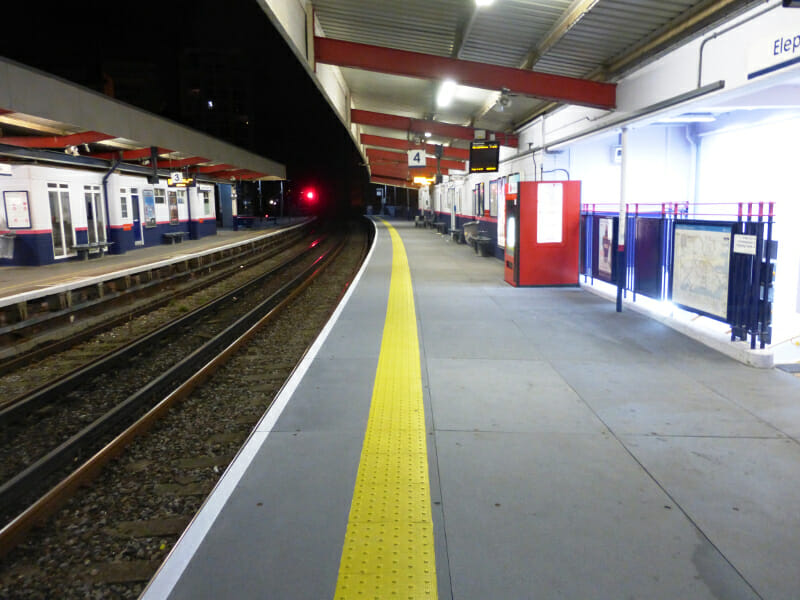
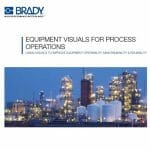





Leave a Reply